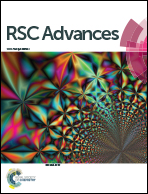“Unrolling” multi-walled carbon nanotubes with ionic liquids: application as fillers in epoxy-based nanocomposites
Abstract
This work describes a straightforward procedure for the preparation of graphene by opening multi-walled carbon nanotubes (CNT), using ionic liquids (IL) as lubricating and stabilizing agents. The sequential application of vacuum and sonication allows the successful opening and unrolling of the CNT, and the final nanocarbon morphology is IL-dependent. This enabled the preparation of epoxy-based nanocomposites with morphologically distinct carbon nanofillers. The CNT–IL mixtures and nanocomposites obtained were characterized by transmission electron microscopy (TEM), scanning electron microscopy (SEM), atomic force microscopy (AFM) and Raman spectroscopy.


 Please wait while we load your content...
Please wait while we load your content...